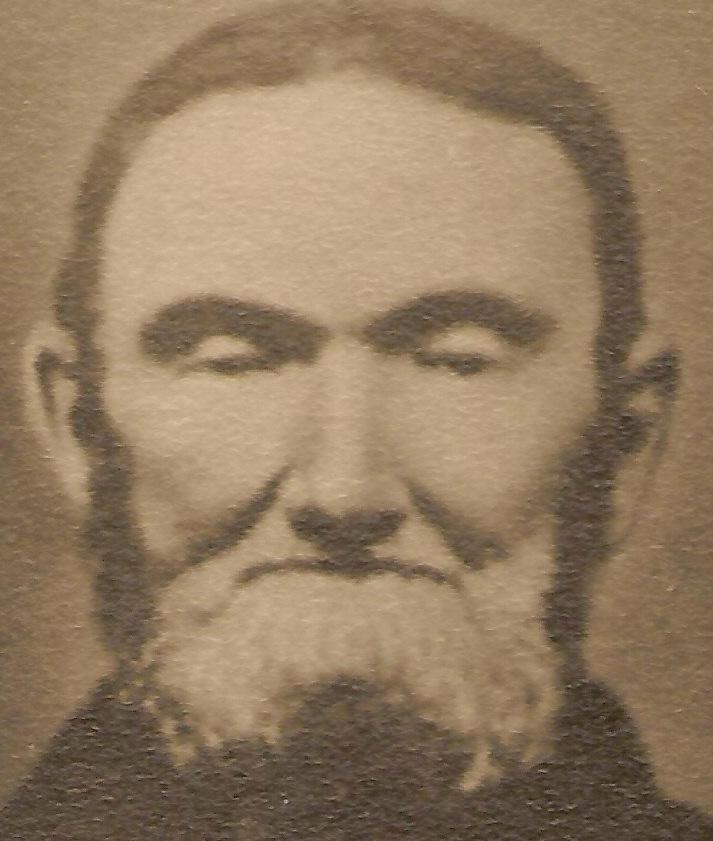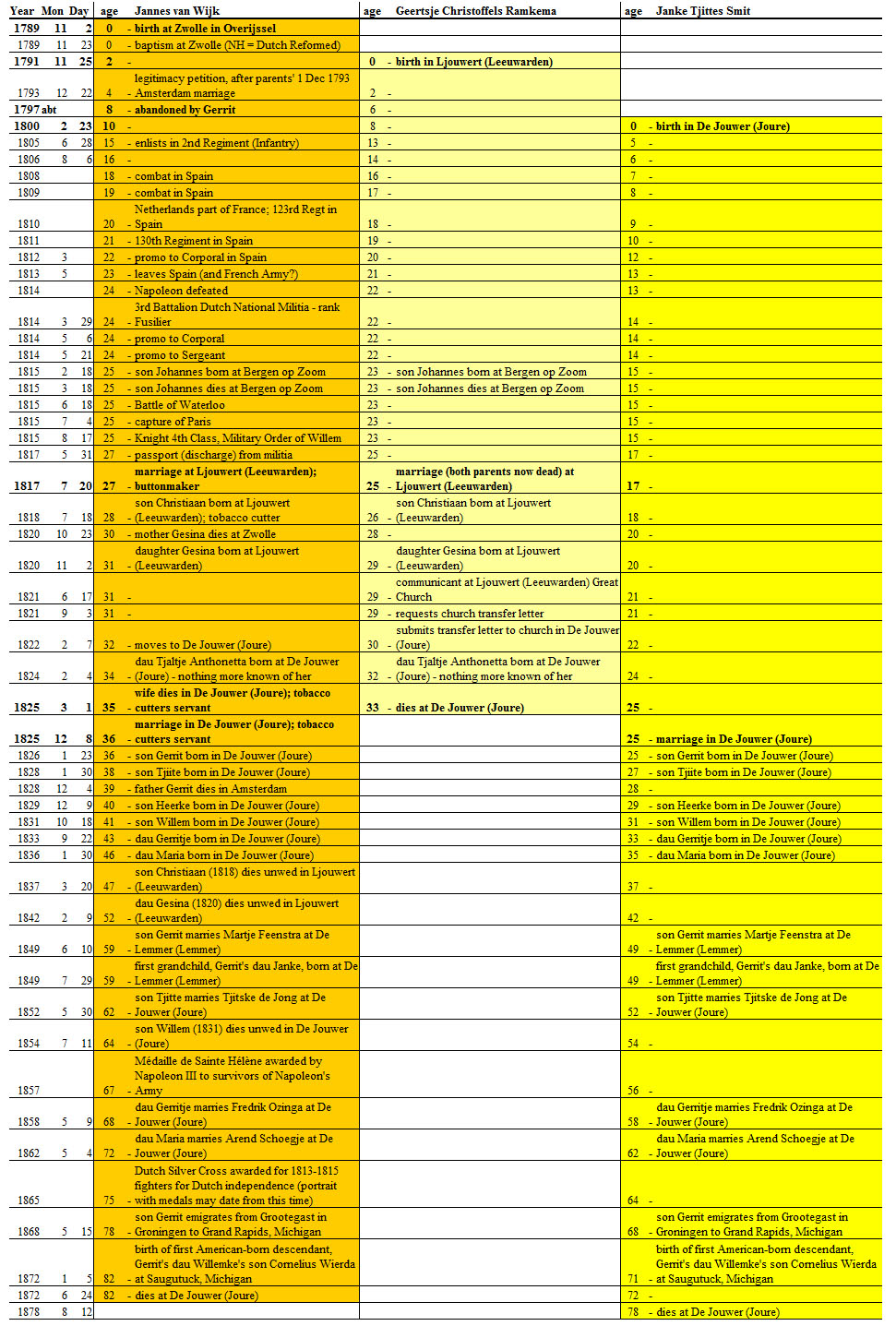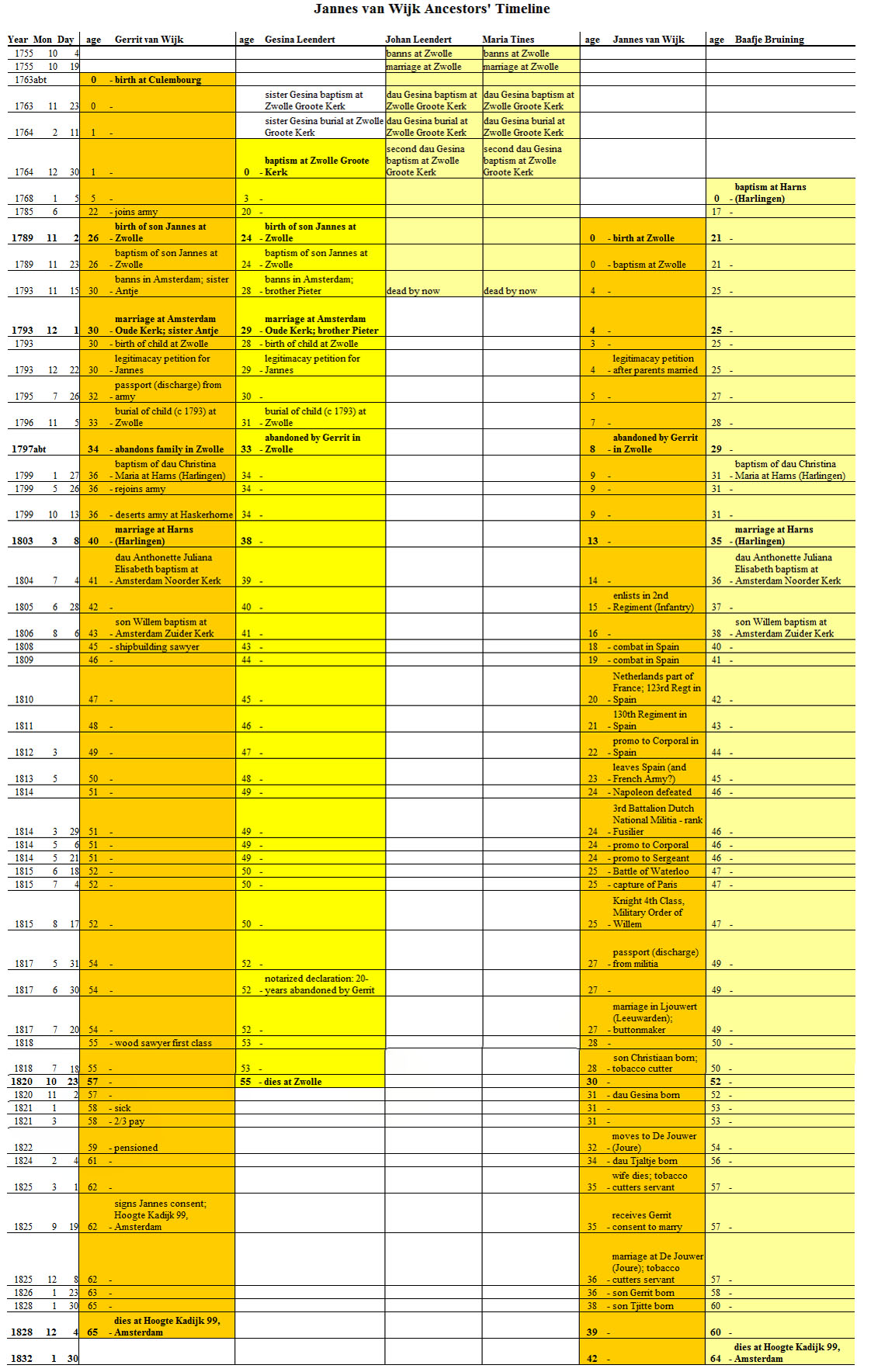 Enlarge |
 Enlarge |
|
This is a companion to my web page on Jannes van Wijk's Descendants in America. Many of those who are his descendants may not realize how illustrious their ancestor was. So this page is intended to give some description of his life and what is known of his ancestry.
|
|
I will begin with a summary of his accomplishments, before giving the chronology of his life and the information about his ancestors. In the only portrait photo that I have of Jannes and Janke, he is proudly wearing three military decorations. And the same decorations are at the top of the long slab that covers the graves of Jannes and Janke at the cemetery in Joure.
When Jannes was young, the Netherlands were under the control of France. So he became a soldier in the Army of Napoleon's brother who was designated King Louis of Holland by Napoleon. In July 1810, France annexed the Netherlands and Louis's army was incorporated into the French Army. Jannes served from 26 Aug 1805 until 19 Mar 1814 when he deserted and joined the Dutch National Militia. While with the French army, he fought in Spain, where he was wounded. Napoleon had abdicated in 1814 but then returned and was finally defeated in 1815 at the battle of Waterloo (in what is now Belgium). Jannes fought 18 Jun 1815 at Waterloo as a Sergeant in the Dutch National Militia against Napoleon, who was finally defeated.
His service under French command saw the following highlights.
His service under Dutch command saw the following highlights.
|
|
Locations in Friesland are in Frysk with Dutch names in parentheses.
 |
|
Jannes' parents were Gerrit van Wijk (abt 1763 Culemborg, Gelderland - 4 Dec 1828 Amsterdam, Noord-Holland) and Gesina Leendert (30 Dec 1764 Zwolle, Overijssel - 23 Oct 1820 Zwolle). When he enlisted in the Army, Gerrit stated that he was born at Culemborg. However, my search of the records of every church in Culemborg in the years surrounding his birth did not find either him nor his apparent sister Antje van Wijk (who is known only because Jannes stayed with her in 1793 prior to his marriage to Gesina). Jacobus Knol did find the banns and marriage records of Gesina's parents (Johannes Francois Leendert and Marie Geertruit Tines) at Zwolle, as well as the baptism and death of their first child, aslo named Gesina. We also know that Gesina had a brother Peter Leendert with whom she stayed in Amsterdam prior to the 1793 marriage, but nothing else is known of him. And that, in a very few words, sums up how far back we know who Jannes' ancestors were. However, thanks to Jacobus Knol's research, we know quite a lot about Jannes' father and his two wives. Jannes was illegitimate when he was born. His father was a soldier, age 26, and his mother was 24. They had a second child about 1793, which was apparently the reason that they married 1 Dec 1793 in Amsterdam and then filed a petition to legiitmize the birth of Jannes. However, in 1796, the other child died (buried at the Bruder Kerk yard, which is now the site of a top-rated restaurant), and soon afterward, Gerrit deserted Gesina and Jannes. Gerrit went to Friesland, where at Harns (Dutch: Harlingen), he fathered a daughter who was born 27 July 1799; the mother was Baafje Bruining. Gerrit then re-enlisted in the Army in May 1799 (at age 36!), only to desert in October 1799, along with a great many others, when the English sent warships to Friesland. Gerrit married Baafje 8 Mar 1803, without divorcing Gesina, so that legally he was a bigamist. There is an unusual report in the records at Harns (Harlingen), which may be related to their marriage. There is a web site with important historical information about residents of Harns. And Baafje shows up in at least two places. The first is the page of B names, where there is a great deal of information about her family and about her and her prior husband (which I have not yet incorporated into the timeline below) and her marriage to Gerrit, who is also on the W names page with a minimal entry about their marriage. The unusual report is on the D page, under Gerrit van Dijk, which is almost certainly a mis-reading of van Wijk. The entry reads: "Christiaan Bruning, accused of beating and molesting [mishandeld] his sister Baafje Bruning; Baafje Bruning accused of first having attacked her brother Christiaan Bruning; Gerrit van Dijk accused of having interfered with the argument and having beaten Christiaan Bruning. After questioning he [Gerrit] has to pay no fine, just the costs and he gets severely reprimanded. February 14, 1803 (B49 = Resolutieboeken, 1802-1803 = daily minutes of the city council)". So it may be that the couple moved to Amsterdam so as not to be near her brother. And with his second marriage, Gerrit finally seems, at age 40, to have settled down and become responsible. He moved his second family to Amsterdam, where his next child was baptized 1804 at the Noorder Kerk (half a mile down and across the canal from the Anne Frank House). His last-known child was baptized at the Zuider Kerk in 1806. They then moved to Hoogte Kadijk 99, where he worked in the nearby shipyards as a sawyer. The Ooster Kerk was just across the inlet from their home, so that they probably went there, which meant that Gerrit had connections to every one of the main churches of Amsterdam except the Wester Kerk (the one just a few doors down from the Anne Frank House, whose bells she could hear until they were melted down for resuse of the metal). When Jannes first married in 1817, he did not know whether his father was alive or dead. But sometime before Jannes remarried in 1825, he found out not only that his father was alive but also made contact with him. His mother Gesina meanwhile had died in poverty at Zwolle in 1820. In 1825, Gerrit formally gave his permission in writing for Jannes' remarriage. By that time, Gerrit was a retired pensioner, after having become sick in 1821. Gerrit and Baafje lived on at Hoogte Kadijk 99, where he died in 1828 and she in 1832. I do not know what became of their three children. However, I found one possible indication that his daughter Anthonette (who may have been the godmother of Jannes' 1824 daughter Tjaltje Anthonetta van Wijk) may have married a Nicolaas Dekker and had a son Karel Cornelis Dekker 1826 in Amsterdam, who married Trijntje Kuiper 20 May 1864 at Den Helder.
Locations in Friesland are in Frysk with Dutch names in parentheses.
 |